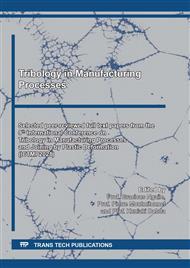p.125
p.133
p.139
p.147
p.155
p.163
p.169
p.179
p.185
Experimental Investigation on Slip Conditions during Thread Rolling with Flat Dies
Abstract:
Rolling operations with flat dies allow the highly efficient production of cylindrical parts in large quantities. [1] Latest trends towards shorter lifecycle times and increasing product complexity [2] strengthen the need for an efficient design process of flat die rolling operations. Finite element modelling plays a major role in establishing an efficient design process. Precise modelling of the friction conditions during rolling operations with flat dies is still posing a challenge today. [3] The present work aims to experimentally identifying the limits of rolling of an axisymmetric part, using flat dies. By gradually increasing the stroke rate, the process limits caused by excessive slippage are determined for six different tribological systems. The workpiece rotation and tool movement is measured optically by using a digital camera system. Large differences in slippage are observed, depending on the tribological system. While systems with polymer based lubricants show excessive slippage at low stroke rates, systems using oil or no lubricant bear higher stroke rates before process limits are reached. Furthermore the optical measurements reveal that slip may also occur without complete process failure leading to the assumption that the process limit of excessive slippage in rolling operations is rather fluent than binary. Based on this experimental data, future investigations will focus on methods to predict these process limits through FEM using advanced friction modelling and tribometer tests.
Info:
Periodical:
Pages:
169-176
Citation:
Online since:
February 2022
Authors:
Keywords:
Price:
Сopyright:
© 2022 Trans Tech Publications Ltd. All Rights Reserved
Share:
Citation:


